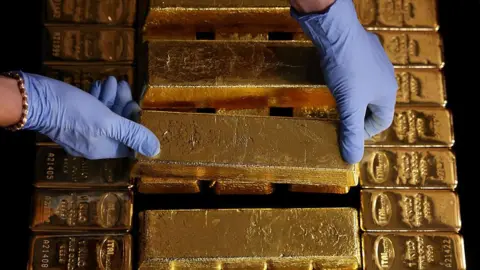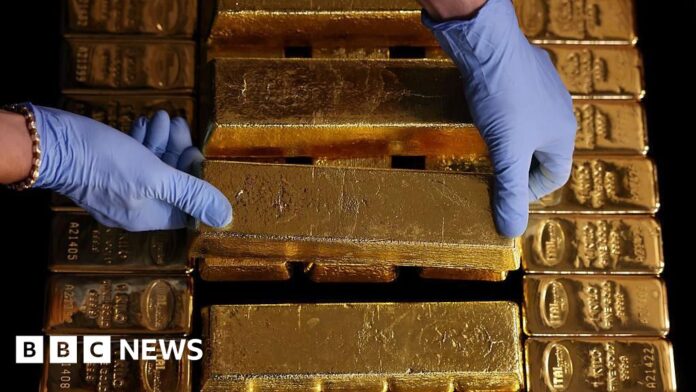Osmond ChiaBusiness reporter and
Faisal IslamEconomics editor
 Bloomberg via Getty Images
Bloomberg via Getty ImagesThe price of gold has hit a record high of more than $4,000 (£2,985) an ounce as investors look for safe places to put their money over concerns about economic and political uncertainty around the world.
Gold has seen its biggest rally since the 1970s, rising by around a third since April when US President Donald Trump announced tariffs which have upset global trade.
Analysts say another issue worrying investors is delays to the release of key economic data as the US government shutdown enters its second week.
Gold is seen as a so-called safe haven investment, which is expected to retain or increase its value during times of market turbulence or economic downturns.
At the same time, the Bank of England (BoE) has warned the value of AI tech companies “appear stretched” with a rising risk of a “sharp correction” to financial markets.
Stock markets in the US, UK and Europe have hit record highs recently as investors try to benefit from a rally in tech companies. A correction would be defined as a fall in these indexes of more than 10%.
The price of spot gold – the real-time market value of the precious metal for immediate delivery – rose to more than $4,036 an ounce on Wednesday afternoon in Asia.
Gold futures – which serve as a gauge of market sentiment – reached the same level on 7 October. Futures are agreements to buy or sell the asset at a pre-determined date in the future.
The US government shutdown, which was triggered by repeated impasses over public spending, is a “tailwind for gold prices”, said OCBC’s Christopher Wong, who is the Singapore-based bank’s rates strategist.
Investors have turned to safe haven assets like gold during previous US government shutdowns.
It rose by nearly 4% during the month-long shutdown in Trump’s first term in the White House.
But gold prices could fall if the shutdown ends more quickly than some investors are expecting, said Mr Wong.
Gold’s “unprecedented rally” in the past month has surpassed analysts’ expectations, said UOB bank’s head of markets strategy Heng Koon How.
He added that the rise is also tied to the weakening US dollar and more non-professional buyers, known as retail investors, purchasing gold.
Although the current surge in gold prices has been triggered by short-term uncertainty, the overall strength of gold is largely the result of central banks buying it as a strategic move away from US treasuries and over-reliance on the strength of the dollar.
Central banks have collectively bought more than 1,000 tonnes of gold each year since 2022, up from an average of 481 tonnes a year between 2010 and 2021. Poland, Turkey, India, Azerbaijan and China were among the leading buyers last year.
Not everyone investing in gold buys the physical precious metal.
Some investors put their money into financial products, such as exchange-traded funds (ETFs), which are backed by gold.
A record $64bn has been invested in gold ETFs so far this year, according to the World Gold Council trade association.
 Getty Images
Getty ImagesGregor Gregersen, the founder of precious metals dealer and storage provider Silver Bullion, said he has seen customers numbers more than double in the last year.
Retail investors, banks and wealthy families have increasingly turned to gold, viewing it as a safeguard against global economic uncertainty, he said.
“Gold will fall at some point, but I believe given the economic environment, it’s on an upward trend for at least five years,” Mr Gregersen said.
Gold may fall in value if there is a hike in interest rates or geopolitical tensions and political uncertainties ease, said OCBC’s Mr Wong.
In April, for instance, the price of gold fell by around 6% after Trump backed off from firing Fed Chair Jerome Powell, he said.
“Gold is often seen as a hedge against uncertainty, but the hedge can be unwound.”
And in 2022, gold’s value plunged from $2,000 to $1,600 an ounce, after the US central bank raised interest rates to curb the inflation triggered by the Covid-19 pandemic, said UOB’s Mr Heng.
A key risk to gold’s current rally is a sudden resurgence in inflation, which could prompt the Federal Reserve to raise rates, he added.
The recent climb in gold prices reflects expectations that the Fed will lower interest rates, making gold more attractive, said Mr Wong.
Meanwhile, Trump has ramped up pressure on the Fed, publicly criticising Mr Powell for not cutting rates quick enough and attempting to fire Fed Governor Lisa Cook.
The president’s targeting of the Fed can “undermine confidence in the [its] ability to act as a credible, inflation-targeting central bank,” said Mr Wong.
In such an environment, gold’s role as a hedge against uncertainty “gains renewed importance,” he said.
The UK’s central bank also raised concerns about the global tariff war and over the credibility of the Fed.
AI warning
While giving UK banks a broadly clean bill of health for resilience against potential shocks, the BoE’s financial policy committee said the record concentration of stock markets on a handful of big tech companies was also a risk.
“A sudden or significant change in perceptions of Federal Reserve credibility could result in a sharp re-pricing of US dollar assets, including in US sovereign debt markets, with the potential for increased volatility, risk premia, and global spillovers,” the committee said.
The committee assesses all financial risks to the economy, and recommends whether banks should take steps to protect financial stability.
In its regular financial stability assessment, the committee identified the still soaring valuations of the world’s biggest tech companies, especially those focused on AI in the US as a concern.
The committee said that on some profit measures, it was “comparable to the peak of the dotcom bubble”, which ended in a huge crash at the turn of the millennium.
In its report, the committee said: “On a number of measures, equity market valuations appear stretched, particularly for technology companies focused on Artificial Intelligence (AI).”

Get our flagship newsletter with all the headlines you need to start the day. Sign up here.




